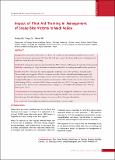Please use this identifier to cite or link to this item:
https://hdl.handle.net/20.500.14356/2003Full metadata record
| DC Field | Value | Language |
|---|---|---|
| dc.contributor.author | Hamal, P K | - |
| dc.contributor.author | Pandey, D P | - |
| dc.contributor.author | Thapa, C L | - |
| dc.date.accessioned | 2023-06-05T07:31:10Z | - |
| dc.date.available | 2023-06-05T07:31:10Z | - |
| dc.date.issued | 2011 | - |
| dc.identifier.citation | HamalP. K., PandeyD. P., & ThapaC. L. (2010). Impact of First Aid Training in Management of Snake Bite Victims in Madi Valley. Journal of Nepal Health Research Council. https://doi.org/10.33314/jnhrc.v0i0.214 | en_US |
| dc.identifier.issn | Print ISSN: 1727-5482; Online ISSN: 1999-6217 | - |
| dc.identifier.uri | http://103.69.126.140:8080/handle/20.500.14356/2003 | - |
| dc.description | Original Article | en_US |
| dc.description.abstract | Abstract Background: Tropical lowland on Nepal is at full of risk to snake bite. The snake bite mortality is due to lack of awareness about proper management of victims. The study aims to assess the change in the pattern of management of snake bite victims after first aid training. Methods: A retrospective study was done from October 2007 to October  2008 among 43 snake bite victims in rural Madi valley comprising of 4 village development committees where first aid training was conducted one yearbefore. Results: Only 26% of the snake bite victims approached traditional healer before arriving at the heath facility. The case fatality rate dropped  to 22% after venomous snake bite. Pressure Immobilization bandaging  and local compression pad immobilization technique was used by 56%  who went to the health facility. Mean duration for reaching health facility was 61.51±33.55 minutes. Common places of bite were field 16 (37.2%), Indoor 6 (14%), while sleeping 6 (14%), and yard 6 (14%). Lower extremity bites were 32 (74.4%), upper extremity 8 (18.6%) and  head 3 (7%). Bicycle was the commonest mode of transport 22 (51%)   followed by ambulance 9(27.9%) and Motorcycle 6 (11%). Conclusions: First aid training changes the attitude of the people in management of snake bite victims and is one of the effective  ways in   decreasing mortality. Nationwide campaigning should be done especially at snake bite prone area about the proper first aid technique to improve the awareness level of the general population. Key words: first aid, mortality rate, snake bite, traditional healer, venomous snake | en_US |
| dc.language.iso | en | en_US |
| dc.publisher | Nepal Health Research Council | en_US |
| dc.relation.ispartofseries | April, 2010;HamalP. K., PandeyD. P., & ThapaC. L. (2010). Impact of First Aid Training in Management of Snake Bite Victims in Madi Valley. Journal of Nepal Health Research Council. https://doi.org/10.33314/jnhrc.v0i0.214 | - |
| dc.subject | Â first aid | en_US |
| dc.subject | Mortality rate | en_US |
| dc.subject | Snake bite | en_US |
| dc.subject | Traditional healer | en_US |
| dc.subject | Venomous snake | en_US |
| dc.title | Impact of First Aid Training in Management of Snake Bite Victims in Madi Valley | en_US |
| dc.type | Journal Article | en_US |
| local.journal.category | Original Article | - |
| Appears in Collections: | Vol 8 No 1 Issue 16 April 2010 | |
Files in This Item:
| File | Description | Size | Format | |
|---|---|---|---|---|
| 214-Article Text-212-1-10-20130822.pdf | Fulltext Download | 190.4 kB | Adobe PDF |  View/Open |
Items in DSpace are protected by copyright, with all rights reserved, unless otherwise indicated.
